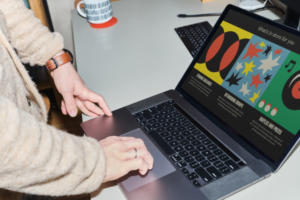Being a freelance designer is an exciting and rewarding career path that offers freedom, creativity, and flexibility. However, it also comes with its unique set of challenges, one of which is dealing with stress and pressure. As a freelance designer, you are responsible for managing multiple projects, meeting client expectations, staying on top of industry trends, and handling the business aspects of your work. The constant demands and tight deadlines can take a toll on your mental and emotional well-being if not managed effectively.
In this article, we will explore valuable strategies and techniques to help you cope with the stress and pressure that often accompany freelance design work. By implementing these tips, you can maintain a healthy work-life balance, improve your productivity, and ensure a positive mindset throughout your career.
Firstly, it’s important to recognize that stress is a natural part of any job, and freelancing is no exception. However, understanding the sources of stress specific to your work can help you address them more effectively. Common stressors for freelance designers include tight deadlines, demanding clients, financial uncertainties, and the need to consistently deliver high-quality work. By identifying these stress triggers, you can develop targeted strategies to manage and minimize their impact on your well-being.
Establishing a healthy work-life balance is crucial for managing stress and pressure. As a freelancer, the boundaries between work and personal life can become blurred. To combat this, set clear boundaries by defining your working hours and creating a designated workspace. This separation helps you switch off from work and focus on self-care and relaxation during your non-working hours. Additionally, schedule regular breaks throughout the day to recharge and prevent burnout. Engaging in activities that you enjoy outside of work, such as hobbies or spending time with loved ones, can also contribute to a healthier work-life balance.
Effective time management is another essential aspect of stress and pressure management. Prioritize your tasks by identifying urgent and important ones, and consider breaking down larger projects into smaller, more manageable tasks. Utilize productivity tools and techniques such as to-do lists, project management apps, and time-blocking methods to optimize your workflow and ensure that you allocate sufficient time to each project. By managing your time effectively, you can reduce the feeling of being overwhelmed and improve your overall productivity.
Furthermore, setting realistic expectations is key to minimizing stress and pressure as a freelance designer. Be transparent with your clients about project timelines, deliverables, and any limitations you may have. Avoid overpromising and underdelivering by providing accurate estimates and being honest about your capabilities. This not only sets realistic expectations for clients but also prevents self-imposed pressure to meet unrealistic demands. By fostering clear and open communication with clients, you can build trust and create a more harmonious working relationship.
Understanding the Sources of Stress
To effectively manage stress, it is crucial to identify the sources that trigger it. As a freelance designer, common stressors may include tight deadlines, demanding clients, financial uncertainties, and the pressure to consistently deliver high-quality work. These factors can create a constant sense of urgency and contribute to elevated stress levels.
To address these stressors, start by analyzing your workload and identifying potential areas of improvement. Assess if you have taken on too many projects simultaneously or if there are certain types of clients or projects that consistently cause stress. By recognizing these patterns, you can make informed decisions about which projects to take on, set realistic expectations with clients, and better manage your workload.
In addition to external stressors, it’s important to acknowledge the internal sources of stress. Perfectionism, self-doubt, and fear of failure are common challenges that many freelance designers face. Learning to manage these internal pressures and develop a growth mindset can help reduce stress and increase resilience. Practice self-compassion and remind yourself that mistakes and setbacks are part of the learning process.
Establishing a Healthy Work-Life Balance
Maintaining a healthy work-life balance is essential for managing stress and pressure as a freelance designer. While the flexibility of freelancing allows you to set your own schedule, it can also blur the boundaries between work and personal life. Here are some strategies to establish a healthy balance:
- Set boundaries: Clearly define your working hours and communicate them to clients. Let them know when you are available for communication and when you will be taking time off.
- Create a dedicated workspace: Designate a specific area in your home or office for work-related activities. Having a separate space can help you mentally switch between work and personal life.
- Schedule breaks: Take regular breaks throughout the day to recharge and avoid burnout. Step away from your workspace, stretch, go for a walk, or engage in activities that help you relax and rejuvenate.
- Prioritize self-care: Make time for activities that nourish your physical, mental, and emotional well-being. Exercise regularly, practice mindfulness or meditation, engage in hobbies, and spend quality time with loved ones.
- Learn to say no: It’s okay to decline projects or requests that do not align with your goals or values. Saying no to excessive workloads or unreasonable client demands is essential for maintaining balance and protecting your well-being.
Effective Time Management Techniques
Effective time management is key to reducing stress and maximizing productivity. Here are some techniques to help you manage your time efficiently:
- Prioritize tasks: Identify the most important and urgent tasks and tackle them first. Use prioritization techniques such as the Eisenhower Matrix or the Pomodoro Technique to allocate time effectively.
- Break down projects: Large projects can be overwhelming, so break them down into smaller, manageable tasks. This allows you to focus on one task at a time and track progress more effectively.
- Use productivity tools: Take advantage of project management and productivity tools such as task management apps, project trackers, and calendar systems. These tools can help you stay organized, set deadlines, and collaborate with clients and team members efficiently.
- Avoid multitasking: While it may seem efficient, multitasking can actually lead to decreased productivity and increased stress. Focus on one task at a time, giving it your full attention before moving on to the next.
- Set realistic deadlines: When agreeing on deadlines with clients, factor in potential delays or unexpected challenges. Be honest about your availability and workload to avoid overcommitting and feeling overwhelmed.
By implementing these time management techniques, you can enhance your productivity, reduce stress, and ensure a healthy work-life balance.
Setting Realistic Expectations
Setting realistic expectations is crucial for managing stress and pressure as a freelance designer. It’s essential to communicate openly and transparently with clients about project timelines, deliverables, and potential limitations.
When discussing a project, be clear about what can be realistically achieved within the given timeframe. If you foresee potential challenges or limitations, discuss them upfront to manage client expectations effectively. Open and honest communication builds trust with clients and helps prevent misunderstandings or dissatisfaction.
Additionally, remember to manage your own expectations. As a perfectionist, it’s natural to strive for excellence, but it’s important to set realistic goals and acknowledge that perfection is rarely attainable. Focus on delivering high-quality work while maintaining a reasonable balance between effort and outcome.
Conclusion
Managing stress and pressure as a freelance designer is an ongoing process that requires self-awareness, effective strategies, and a commitment to self-care. By understanding the sources of stress, establishing a healthy work-life balance, practicing effective time management, setting realistic expectations, and prioritizing your well-being, you can navigate the challenges of freelancing with resilience and success.
Remember, everyone experiences stress differently, so it’s important to experiment and find the strategies that work best for you. Regularly reassess your workload, boundaries, and self-care practices to ensure they align with your overall well-being and professional goals. By taking proactive steps to manage stress and pressure, you can create a sustainable and fulfilling career as a freelance designer.



